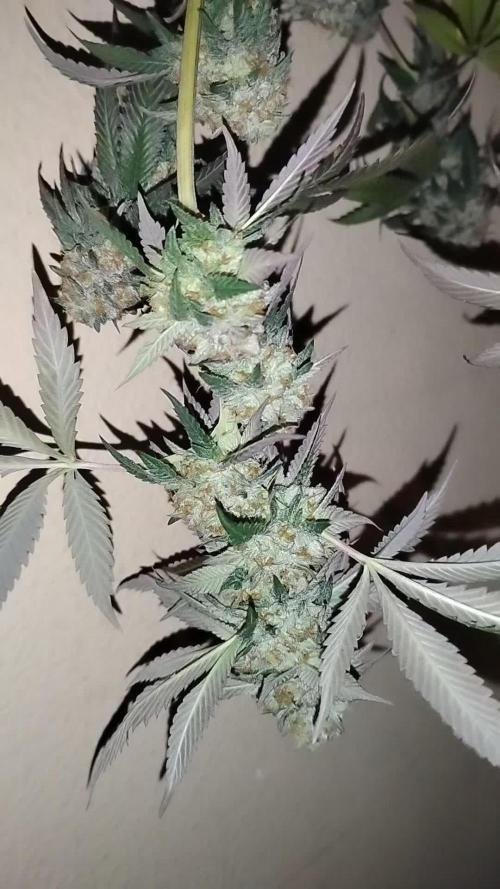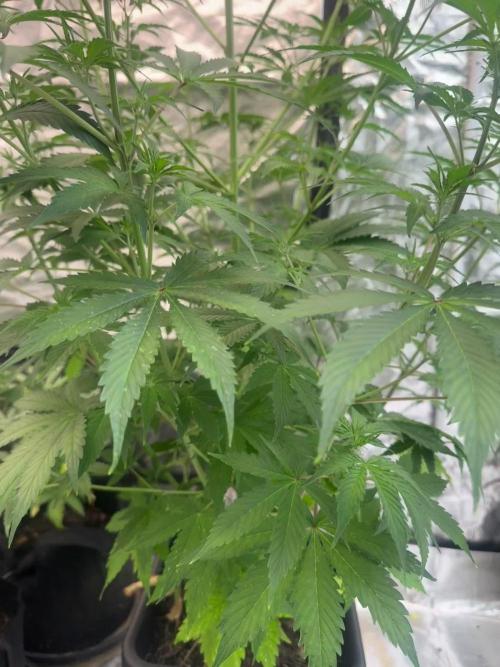The Grow Awards 2026 🏆 

































Likes
Comments
Share


@Compassionate_Gardener
Follow
Shortly after they were switched to flowering (after week 3) the plants continue to stretch and then start to develop their first flowers. Now in week 7 all plants have very nice flower clusters all over the plant and side branches. They have grown to 45 cm (=Shiva Skunk on left side) and 40 cm (Serious Kush on right side of aisle) in height respectively and all plants have a nice dark green color, which shows they are healthy and also that the Advanced Nutrients schedule works like a treat. The Q6W-Gen.2 LED-Lamps are now dimmed to 100% (=three green LEDs on the dimmer) and work on FULL POWER, which ensures full fledged flower production. Both varieties have now started to exude their typical aroma. The Shiva Skunk starts to smell musky and sweet, while the Serious Kush smells 'gassy' and 'fuely' like its OG-Kush heritage. The flower clusters on the Serious Kush appear to grow denser than the clusters on the Shiva Skunk.
Likes
2
Share


@eldruida_lamota
Follow
Que pasa familia, vamos con la octava semana de floración de estas Gorilla Cookies Fast Flowering, de FastBuds.
Agradezco a Agrobeta todos los kits obtenidos de ellos 🙏.
Hasta aquí veis que llevan buen progreso y el color que se marcan es espectacular.
Vamos al lío, el ph se controla en 6.2 , la temperatura la tenemos entre 22/24 grados y la humedad ronda el 50%. El fotoperiodo a 12-12. Estás próximas semanas veremos cómo avanzan.
Agrobeta:
https://www.agrobeta.com/agrobetatiendaonline/36-abonos-canamo
Hasta aquí todo, Buenos humos 💨💨💨
Processing
Likes
6
Share


@Mr_nugs_lover_David
Follow
She's responding super good to lst method she looks absolutely gorgeous I would have loved to be able to grow her since march however It was not posible but I keep this wonderful indica in my list. This wonderful pheno of Alien gorilla has started flower the 3rd of August.
Likes
9
Share


@AestheticGenetix
Follow
7/18/25 chopped and hung. Will update with more pictures and videos and dry weight in 5-7 days
Likes
2
Share


@Firepharmer
Follow
Trichomes trichomes !! What a beautiful plant 🌱 to grow , not big bud producers but absolutely coated.u can definitely tell it’s got the GCS in her , Terps are getting stronger now that really forum cut Girl Scout cookies terps with some creamy peanut tons . The stretch is about over now
Likes
33
Share


@NuggetPawn
Follow
Howdy!
I have premixed 1L worth of PH adjusted nutrient solution which I am periodically syringing on top of the rock wool when it starts to get dry. I see some people only use RO water with cal-mag to start them off, but through my own unscientific opinion I figured 550 PPM won’t hurt considering seeds grow in soil and that isn’t exactly nutrient free!
I am using RO water which I will keep in a 70 litre bucket ready for the DWC system once it is up and running. RO system was only £50/$80/€60 from the internet and it’s getting my hard water down to 0-1PPM from 450PPM.
Growing my ladies in a smallish tent, 60 x 120cm which is 180cm high.
Using one 315w LEC/CMH for the first two weeks, and then adding another 315w after week two. Using 4200k bulbs for veg, 3200k bulbs for bloom.
Will take more pictures of the set up in the next week or so once the babies are in the 70 litre DWC Bubble System.
Planning on buying Silica Blast to compliment nutrients in the next week or so.
Ps, I believe this is the first DWC grow diary for Strawberry Lemonade, hopefully my mistakes and successes over coming weeks will help anyone who reads this!
🌱
Likes
23
Share


@MadeInGermany
Follow
Hey guys :-)
This week she has developed very well.
For reasons of time, I topped them again on all the drives that were already high :-)
Unfortunately, there is still some time until there is room in the blossom tent.
That's why I'll have to train them a little more 😂.
Was poured 3 times this week with 1 l each. (nutrients see table above)
Since there are still trips in the vegetarian tent, the next few weeks will be treated again with nematodes and neem oil :-( .
Otherwise everything was cleaned.
Have fun with the update and stay healthy 💚🙏🏻
👇🏼👇🏼👇🏼👇🏼👇🏼👇🏼👇🏼👇🏼👇🏼👇🏼👇🏼👇🏼
You can buy this Nutrients at :
https://greenbuzzliquids.com/en/shop/
With the discount code: Made_in_Germany you get a discount of 15% on all products from an order value of 100 euros.
👇🏼👇🏼👇🏼👇🏼👇🏼👇🏼👇🏼👇🏼👇🏼👇🏼👇🏼👇🏼
You can buy this strain at :
https://www.thegratefulseeds.com/shop/feminized-seeds/limited-edition/blue-javaz/
Water 💧 💧💧
Osmosis water mixed with normal water (24 hours stale that the chlorine evaporates) to 0.2 EC. Add Cal / Mag to 0.4 Ec Ph with Organic Ph - to 5.8 - 6.4
MadeInGermany
Likes
89
Share


@Njanne
Follow
I found this seed in bud that I harvested from my Barney's Liberty Haze plant. It was grown in my grow room and you can see my GrowDiary log of that plant. I am not sure exactly how I ended up with seeds... maybe there was light or temperature stress which resulted in a herm. In any case, I decided to grow this seed as a fun experiment. I didn't even know if the seed would germinate... but it grew just FINE. I didn't top it, or give it any special treatment. I guess you could say she grew 'native' or 'au natural.' I have never grown outside before, but I had space in the garden, and the seedling looked healthy, so I hardened her off and popped her into the dirt. She ended up going into a huge monster of a plant. Standing over 9 feet tall I had to laugh out loud each time I climbed the ladder to inspect her top cola LOL. I had so much fun growing this plant.
I called her Majestic Haze (we live on Majestic Drive) because I'm not sure if Barney's would want me calling her Liberty Haze. I can't verify the genetics for sure :) I wonder how plant breeders handle those kinds of things??...
This bud is fun for parties and conversation. It starts out with an energetic vibe and then settles into a relaxed chill stoned feeling. We vaped our dried bud, and then we tried some of our hand rolled hash... then we settled in for the night. Woke up a sit high still LOL but it's Saturday and we don't need to go anywhere so it's all good LOL... This one is the bud of choice for house parties and silly Netflix watching. PS if you haven't see The Good Place... you need to get stoned and watch it.
The total dried weight of bud from this plant was just under one pound @ 310g and we also ended up with around 120 g of frosty trim. We also rolled up about a gram of hash which has some serious kick :)
Likes
11
Share


@Mazgoth
Follow
Really resistance to anything that is causing her stress and as always really good yields even in worst case scenarios.
Processing
Likes
15
Share


@eldruida_lamota
Follow
Que pasa familia, venimos de nuevo ,actualizamos otra semana de floración y es que nuestras crazy cookies están cogiendo un tamaño colosal, todavía escupen flores, seguiremos abonando con advanced nutrients con el ph regulado correctamente, bajamos algo más la humedad prefiero que a esta altura ya no supere el 40%.
Hemos hecho una limpia de hojas bajeras y la luz ya asoma por todas las partes de la planta. Ya hasta la semana que viene suficiente, un saludo para todos los fumetillas.
Likes
2
Share


@ibbzy
Follow
Jesus she's a beast. AutoPots where made for auto flowers! Biggest auto I've grown so far. Literally plant tripled in size this week 😫
Likes
321
Share


@Tropicannibis_Todd
Follow
Alrighty My Friends
I had a blast growing this stuff , everytime I grow this plant its fire 🔥 and its always the same pheno so far , truly amazing 👏 stuff
Nothing but budz on a stick 👌Would not only recommend 😉 but I will go a far as stating this the best smoke I've had grown to date 😋
👉Soil Provided by ProMix.ca
👉Nutrients Provided by Agrogardens
👉Lighting Provided by MarsHydro.ca
Thanks my friends for the great support over the years 🙏 Happy Growing
Likes
14
Share


@SkunkyDog
Follow
Hallo zusammen 🤙.
Sie wachsen sehr schön.
Sie erhalten 25 Prozent Rabatt in unserem Shop
Mindestbestellwert beträgt 75 Euro
https://greenbuzzliquids.com/en/shop/
Code: GD42025
Likes
5
Share


@Naujas
Follow
the girl is growing:) although there was no sun for a few days and there was a strong wind:) she is fine:) I didn't water it, it was raining so I didn't need it:) see you next week.
Likes
5
Share


@BettaN
Follow
Still fighting the heat, added a stronger bottom vent, managed to stabilize the temp to 25C.
Relative Humidity is still a bit high, specially when opening the tent in the morning and at nighttime.
AC working strong.
Started taking PH measurements, though not very accurately (chem test).
Apparently my mix of 2:1 Brita/tap water was good, the water in the tap is very alkaline (>8), the filter reduces the PH nicely.
I read that Brita also filters out CalMag, so I've added a little boost.
I'll stop using the greengro nutrient next week, I think it's Nitrogen level is too high.
I received Johnny Green's Greengro in a grow deal, the other nutrients (except CalMag) are from the same line.
Likes
Comments
Share


@Billy_Piff
Follow
Amazing plant to grow. By far my favorite out of the sweet seeds f1 fast line. Flower looks feels and smells like indoor. Couldn’t be happier and couldn’t recommend this enough especially to anyone growing with shorter flowering seasons.
Likes
35
Share


@DudeGrowsWeed
Follow
Overall everything is doing great. The Cream & Cheese CBD+ has medium trichome coverage and medium density. But she is the bushiest with the most amount of sugar leaves down the stalks with the buds. I think I'm about a month away from harvest. I'm not going to rush it, but that's what my guess is for now.
Fed MegaCrop and CalMag this week as well as just straight water.





















